Month in the life of an urban gardener: October 2024.
The tasks, problem solving, wildlife spots, learnings and reflections from an organic food grower in a North London kitchen garden.
Welcome to this separate reflection — as part of the Food-Fibre-Fashion publication — on what it’s like to be an urban organic food grower. This started as short snappy videos to condense moments across a month, before realising that actually the narrative and context behind them could be useful, whether successes or mistakes.
As this is part of the wider Food-Fibre-Fashion publication that shares essays, articles and resource newsletters, there will be stories and musings to raise your awareness of how interconnected these systems are, even when we’re looking in small scale, such as an urban garden.
Watch reels of previous months here → September 2024. / August 2024. / July 2024. / June 2024. / May 2024. / April 2024. / March 2024. / February 2024. / January 2024. / December 2023. / November 2023. / October 2023. / September 2023. / August 2023. / July 2023. / June 2023. / May 2023. / April 2023. / March 2023.
This is the twelfth in this series of articles — A Month in the Life of an Urban Gardener. To read about the context of where I work, head to the first article.
Watch October 2024 in the form of a reel here.
You can also listen as a podcast on Spotify, Apple Podcasts — and below →

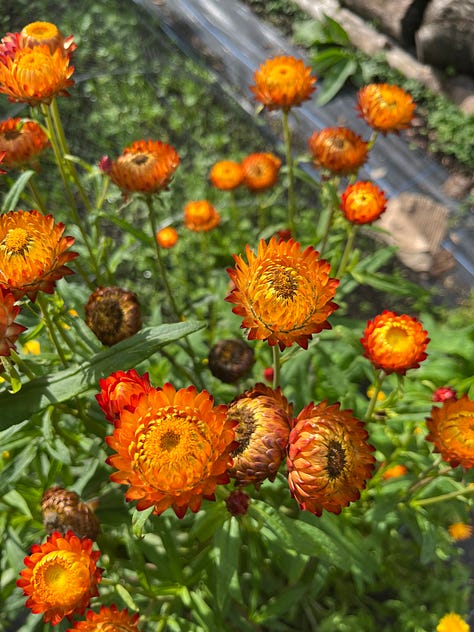

Harvesting.
Blue corn.
Being the first time growing this crop as a dye plant, I was unsure when it was best to harvest. The guess was that ideally you’d wait until the cobs were fully-formed so the kernels were full of blue pigment, but the visible tips were being nibbled by caterpillars of some variety. They were harvested on a dry day, peeled and revealed. The kernels were almost iridescent and a delight to behold. Not all were formed, and from five plants we got six cobs of varying sizes and amounts of blue kernels — but as an experiment, this felt successful. The cobs were left to dry in my bedroom, with caterpillars picked out, though eventually the veg became fluffy with mould and it was time to process even if not fully dry. Sorting out the better looking kernels for next year’s sowing, the little tub for dyeing isn’t huge, and yet it overall was a gift. On top of the kernels were a ball of filament hair strands and husk layers, which will be used in nature weaving workshops, and the stalks themselves, which will be used to see if dye can be extracted from them too based on a recommendation from a fellow dyer.
Gratitude to Nature’s Rainbow and Lea Valley Guild of Spinners, Weavers and Dyers for the inspirational and the physical seed.



Apples.
I thought we were done with apples after our pressing day in mid-September, but we had a visit from a previous contact that there were apples going. This is a glorious little cox-like tree in a superb garden full of sculptures, so a delight to glean. We then did a mini press that same day along with a couple bags of a golden delicious type that were also donated to make a crisp clear sweet juice. It really is a privilege to be able to do this, yet it’s one of those processes that are overlooked. Of course on an industrial scale, the juice cartons we purchase from supermarkets are never going to have variety or origin, and we’re disconnected.
Unfortunately, supermarkets greenwash (or farmwash) by advertising their produce as British when in fact they mix in the small handful from other countries where apples aren’t even in season, and so they’ll have been kept in cold storage. It’s not only an insult to the breadth of orchards we have in the UK, but the farmers who do the work to nurture the trees. Frankly, a lot are still bought from massive farms who likely use pesticides and don’t cultivate soil health or biodiversity, and you’re buying them in crinkly plastic. And perhaps it then feels shocking, when you’re looking at real more-likely-organically-grown British produce, to find a bottle of freshly pressed juice as £6 or a wonky fruit for £1 each. It’s important that the knowledge of orcharding isn’t lost, and that everyday folk recognise their integral role in a strong food system. Partially, that needs to come from awareness of what’s available on doorsteps — all the fruit trees in cities that aren’t harvested, either because we don’t know if we’re allowed to, or because the produce isn’t the quality we’d expect to buy from a shop.
For your insight:
Farmers against farmwashing — a campaign from Riverford calling out supermarkets for their misleading marketing regarding British farms.
The Gleaning Network — a distributed network of independent gleaning hubs across England, Wales and Scotland.
The Orchard Project — UK national charity dedicated to creating, maintaining and celebrating community orchards.


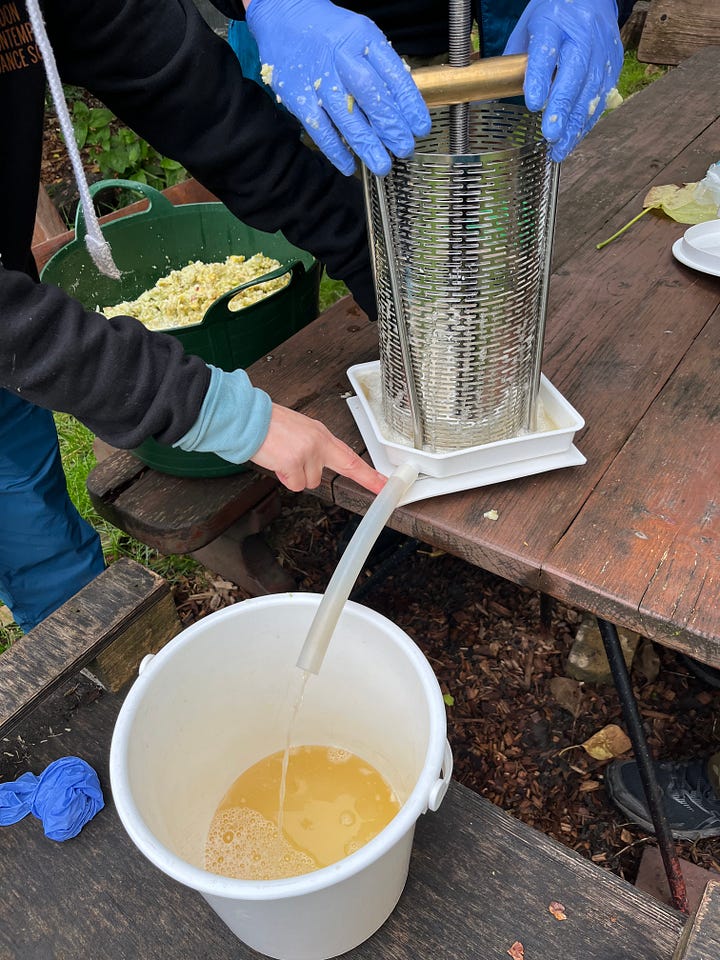

Herbs and veg.
Apart from your evergreen herbaceous shrubs, such as rosemary, November is likely the last chance to harvest fresh herbs before they die back for winter — or indeed to save seed if they’re an annual. Growing tender annuals, including parsley and coriander is possible, particularly if you have a greenhouse or polytunnel for additional warmth. Some do give winter joy, like the three-cornered leek.
In terms of veg, we had loads of salad, chard, and even a solid looking patch of kale despite it not being in the ground very long. We’d attempted to showcase our offerings by making bundles of fresh greens and herbs, but obviously the café team didn’t respond effectively and it was a waste. It’s the biggest frustration, and yet there’s just total apathy across the business. False marketing or lack of communication does not equal sustainability, and that’s all we are — a meaningless greenwashed term; yet again I have to challenge what our purpose is, all because we harvested the most wonderful food that people don’t recognise the power of.



Kiwis.
Yes, kiwis can grow in London. Particularly if you have a south-facing brick wall. This variety is ‘Jenny’ — or Actinidia deliciosa — and she’s bloody vigorous. Jenny likes it hard — that is, her pruning. As a climbing vine, she gets all up the Victorian-building wall and throws out new shoots long enough to catch people in the face even seemingly a week after having been cut. The fruits we harvest are small, like only an inch, and they’re more hairy than a supermarket kiwi (because they’ve been bred to not be hairy). We harvest them in October and let them ripen off the tree, but we fondle them each workday to check for ripeness and try to catch them before the mice find them.


Sweet potatoes.
Despite my lamentations that we’re just out here growing some stuff that no one cares about, there is gratitude saturated amongst the folk that truly understand. I admit that I really wasn’t that bothered about the sweet potatoes, which is why it was a surprise when my colleagues said they waited for me to return from holiday to harvest the few metres of root veg. On harvest day — the festival of Samhain, or Hallowe’en — it actually caused me anxiety to watch the ground be tilled to dig up these roots, and I had to go back to my tidying maintenance project.
The roots were washed and put in the campfire, and we ate them gathered around a candle-lit table. About 15 “normal-sized” potatoes came out of a handful of what’s known as slips — the lengthier root that can be planted in the ground — with a boxful of smaller roots. For a few months workand waiting, that’s not much to show. Granted I didn’t help with cultivation in any way, but know they didn’t require much once in the ground. This is the magic of food growing; essentially making something to nourish physically and emotionally, out of just the tiniest bit of genetic material. We simply need to share wisdom and stories and spaces.
Samhain is about acknowledging that the dark is coming. We pass closely to the world of the dead during the night and celebrate this thinning of the veil with food, drink and revelry — as all Celtic festivals have. We drank of the perry fermented from gleaned pears, and some not-quite-ready cider from gleaned apples — mixed in with mead for sweetness — and shotted some gifted rosehip vodka. It may be that our purpose is lost on some of those around us, though it’s not lost on our team and the volunteers that dedicate their time to learning and being outdoors and sharing in these rituals.




Sowing + planting out.
Changeover of tomatoes.
Early October and it was time to remove the tomatoes, signalling the end of summer. Daylight was dwindling and the green fruits left on the plants wouldn’t ripen. In actuality, because we didn’t get to sowing or planting in the polytunnel, those stalks could’ve stayed in the ground and maybe we’d have had more ripe tomatoes than we got.
Sowing and potting on lettuces and mustards.
Ordinarily we’d have hundreds of mustard and lettuce plants to go out in the polytunnel, glasshouse and salad beds, but they’re just not growing. Even on heat pads with doors closed to keep warmth in, the seedlings are slow. Some mustards were sown directly in the glasshouse, and they’re static.
It’s strange, to be somewhat wired to need a particular growing plan. I’ll have participated in this same rotation and sowing schedule for six years — after having started volunteering in October 2018. All I know is mustards in the winter. I crave that fiery taste for myself. But, we still don’t have customers. I need to get my head in the game and do the outreach, because honestly, these salad varieties are absolutely glorious and can educate folk on what leaves are supposed to taste like. Not generic, not tasteless. However, it’s been grey out for weeks now and the little plantlings aren’t responding to it, so maybe we won’t have any crops anyway.



Tidying up of cuttings and repotting.
It’s time to be organising. Summer’s all go, but now is chance to take stock. The poor forgotten-about cuttings can be repotted to give space — and a reminder of what we have. The lemon geraniums gave me a headache with their overpowering scent. Before winter comes, this limbo period is an opportunity to get some bits in the ground and clear indoor space for anything tender that will need more warmth or need fleecing.
I’d been able to get out some dye plants — the weld and woad — though the dyer’s greenweed, dyer’s camomile, lady’s bedstraw and madder weren’t quite ready so they’re still awaiting their turn. Lamb’s ear and hollyhocks were planted out and were looking established. Unfortunately, a lot of pots aren’t labelled, or they lose their labels, or the writing disintegrates, and we’re left with unidentifiable sticks. You win some, you lose some.



Planting out kale.
It’s a surpise to see the kale plants doing so well after many poor germinations and caterpillar nibbles. We even have plants to backfill (or squeeze in). Once in the ground, rooted well, and covered with a netted structure, they really don’t need anything and will keep going throughout winter. A video of David Beckham popped up on my feed of him showing off his very leafy kale plants.
Sowing garlic.
We’d suffered allium fly badly this year, on top of rust, and so it was decided not to plant garlic in this part of the garden, but some did go in down in the miniplots allotment area. Hopefully the soil there is safe from the eggs. Instead of garlic in the large and small beds normally sown up in the annual veg patch, green manure (or cover crop) was sown instead. This should refresh the soil and build nutrition.
Sowing broad beans.
The French and runner beans bed, and the pea bed, is transferred to broad beans for winter. Come the end of October there were already shoots visible above ground. It really is impressive that there are plants hardy enough to withstand our erratic winter temperatures; the kale and broad beans, and in fact the chard and mustards too, simply wait it out. Joyful shades of green and frost-induced flavours to lighten up the dark.



Maintenance.
Long path.
I’d only gone over to collect the chard seedlings that had seeded in the path’s weed suppressant, but then I decided I’d been bothered too long with how wayward this area was and I needed to take action. I’d just returned from a week in the Lake District and think I desired practicality. Lifting up the plastic sheeting (and in some areas an additional two more layers of older cloth suppressant); smoothing out the path; re-laying and adding fresh new pieces of sheeting; doing way more pinning so it all stays down; and then giving myself a hearty pat on the back for how glorious it now all looked — and also how much safer!


Medicinal garden.
I only went to trim the lavender. This front section of our garden houses lavender, and then some other random medicinal plants, a row of currant bushes and then the espalier trees along a wall. It bothers me every time I walk past that the grass is encroaching on the path, and that overall it looks messy, and not particularly in an intentional way. The ivy was wrapped around the weakened lavender shrubs, the rock wall had partially dismantled, and the medicinal delights couldn’t be distinguished.
Because I’d felt untethered post-holidays (and generally busy summer), this consolidation mentally and physically grounds me. Tidying up genuinely makes me feel better. Satisfaction, purpose, and frankly, alone time. So this section became a mini project. It’s one I realistically knew would lead to many steps in the chain before it was finished, but recognised would have a fairly quick visual impact. Plus, I’d be able to get out some plants that were in rootballed limbo elsewhere in the garden, awaiting a permanent home.
First stage after trimming the lavender, was to cut away ivy, replace the fallen wall, and find the submerged plants. This led to ripping up grass tussocks that served no purpose. Concrete posts used to edge the bed were revealed, which many didn’t realise were there, buried under yearly layers of broken down wood chip. The next stages are to do more weeding, label the plants that are there ready for winter when they’ll die back and be unidentifiable, and put in plants to re-establish this medicinal bit.



Leaf mould and Herbistan.
This is, of course, leaf fall season. Councils have employees blowing or jet-washing leaves off pavements using diesel-powered machinery, while gardeners are raking leaves to scurry them away for essential low nutrient organic matter. The Leaf Mould Bay required some sorting and tidying, so that broken down matter was sieved and stored, and bays were emptied for new leaves to break down in.
This combined with a need to be tidying Herbistan, through: moving stashed rotting scaffolding planks; chopping down herbaceous perennials; re-lining paths; re-applying drip irrigation pipes; re-pinning bramble vines. The lengthier jobs of digging up horseradish and refreshing the strawberry beds were also added to the task list. This whole area feels me with dread because it’s actually a bit of a health and safety nightmare with terrible paths and things in the way, but hopefully visitors aren’t running around it when we’re not working.
There’s also the whole Herbistan entrance with cinque foil taking over the ground, and wood chip encroaching onto the stems of gooseberries and currants, but at least the rosemary that I attempted to save with mulch seems to have recovered. Plus, the yacón is in its moment, being currently the bushiest, greenest, most alive bit of the garden.
Cob oven.
The cob oven had its final layer plastered on and so we hope come December we’ll have a Magic Pizza Day to inaugurate it. Thank you to Frank for the skill and effort yet again to repair this integral feature.


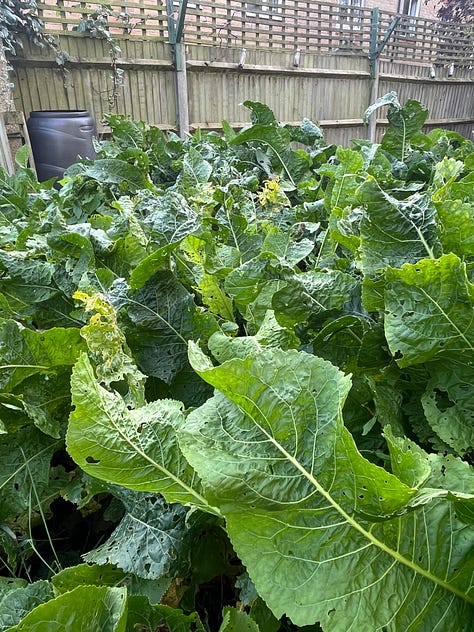
Wildlife.
Squirrels.
You could almost sense their anxiety, literally squirrelling away their food stores. We’d noticed squirrel feet marks in a trug of still-slightly-wet cob oven clay, which was probably a shock when it jumped in there. They’d also been sneaking into the apple crates we’d stacked in our roundhouse pre-pressing to have a nibble — including, during the day when we were around, the 1.4 kilo Howgate Wonder — so once discovered and chucked into the forest because they might as well carry on eating, they started squabbling with each other. We’d found half a tail on the floor, then noticed one of the fighters with half a tail, but it lost and scampered away… only to be grabbed in mouth by a neighbourhood cat and taken away. No amount of screaming at the cat made it drop it’s find. We don’t know if it was serendipitous or sleuthing, though it made me like that particular cat more for it’s tenacity.



Toads and frogs.
As always they’re disturbed when we’re digging stuff up or moving things around. They do find unusual resting places. I’d gone over to feed the worms and heard a plop, then in my peripheral spotted a frog swimming in a small tub on the ground. I asked if it was trying to get out because it looked like it was trying to escape, so I got it out and popped it on a brick. My colleague said she’d seen the same frog in that tub, so it’s obviously just where it lives (or it keeps falling in). Another I was chasing around a salad bed for an hour when weeding it. Froggo dramatically jumped up and landed in the centre of a lettuce.



Beekeeping.
At the start of October, our four honeybee hives were still foraging busily but temperatures were due to drop overnight for one week to 5˚C. This causes the honeybees to retreat inside to keep the hive (and effectively the brood) warm — at 37.5˚C in fact. If temperatures remain like this, and they haven’t managed to forage enough nectar to convert to honey for their winter food stores, they would likely struggle. Numbers start to drop off, because they know cold is coming, and eggs are not laid and therefore “babies” not hatched, which consequently means after a few weeks once they’ve cycled through their various roles, less foragers going out. That the weather warmed up again is actually an issue, as the numbers start to drop, yet they’re sort of programmed to want to go out to forage. This means less bees keeping the hive warm, but also less foragers available.
Intervention may be required to provide them with additional food, so subsequently they don’t put energy into foraging when they should be putting it into hive temperature. We’d needed to inspect anyway, to check for any disease or other issues, and we combined this with weighing the hives. Getting an estimate of the weight of each hive can help figure out how much honey they’re likely to have, without having to take out each bar or frame — which frankly we can’t do with three of the four hives anyway; one is a log hive so can’t really be accessed, and two have cross-combed (built wax comb across bars) and so the bars can’t be removed without devastation.

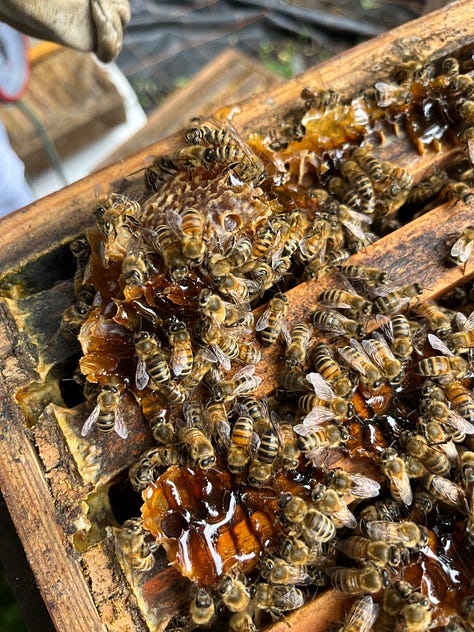

You can see in the photo that lifting the top box away from the lower box caused some cells to break in comb that was joined to the bar below — luckily it was honey and not brood that they’d put at that intersection, and they simply stuck their tongues in to recuperate the liquid. This is just one reason why intervening is bad; you’re ripping their home apart. One piece of comb fell from a bar that had loose foundation, though as testament to their relaxed demeanour, they weren’t particularly bothered by this and carried on as they were (no reaction towards us).
The estimate is 12kg of honey for a standard-sized family to get them nicely through a usual-length winter season. The smaller warre hive family had an estimated 7kg of honey, and we anticipated that they’d have perhaps a month of additional foraging, even with the temperature drop. This hive should get additional food to help them. The larger warre hive family were about 15kg, had always been super active, and had even survived last winter without a full box. The log hive as I said we can’t check or even give additional food to, but as it’s technically a “wild” family, it’s sort of best to let them get on with things on their own terms anyway.
The largest family, what we call the National (or otherwise Langstroth) hive, we had anticipated would have boxes of honey. They had two double depth and two shallow depth boxes, were always super active, had swarmed twice, and had a frame removed last year because they were fully stocked. On inspecting, we immediately noticed they were fairly ridden with wax moth grubs and eggs. Generally, as such a big family (40,000 individuals?) they can fight off an infestation, though we removed what we could, obviously, to help. But on taking out a couple frames from the top box (which should all be capped honey), we only saw smatterings of capped honey and otherwise empty cells. It was the same in the box second from the top.
Now, this is a very active family and somewhat defensive also. It gets to a point with them where they’re fed up of us being there, so we were unable to get any further into the inspection before all three of us were just a bit stressed and freaked. It’s an issue because it seems as if they have two boxes of half-honey, and we couldn’t check where the brood was or what it was doing. We’d left this one until last in anticipation that we’d be taking a frame of capped honey again, to process and then feed to the smaller family. But it was unclear how prepared they actually were, and regardless, taking a half-full comb of capped honey is pointless as you’re destroying great foundations — plus, it was really dark comb too, showing the layers of propolisation i.e. they’ve been cleaned, many times. That’s something you don’t want to destroy, and you don’t want to make them work harder through structure-building.
We’d decided to do another inspection later on, but it’s now the start of November and we haven’t done that. The weather has actually been mild, with no rainy days, and only just now starting to consistently drop in temperature. I did in fact open the smaller hive again the day after our inspection, in order to show our trainees and some volunteers inside because it’s not a common thing to see, and again they were chill though also very active. As the temperature stays lower, they’ll be given either some liquid sugar feed or a block of fondant; feeding them sugar isn’t good for their digestion, but as we don’t have any recently processed honey from our apiary, it’s better than not giving them something. If they don’t feel they want it, then they won’t take it. We’ll also take the lowest box from the hives so the stack becomes smaller, making it easier for them to keep the temperature, and also put a mouse guard on the entrance to prevent mice from seeking a winter home and food.



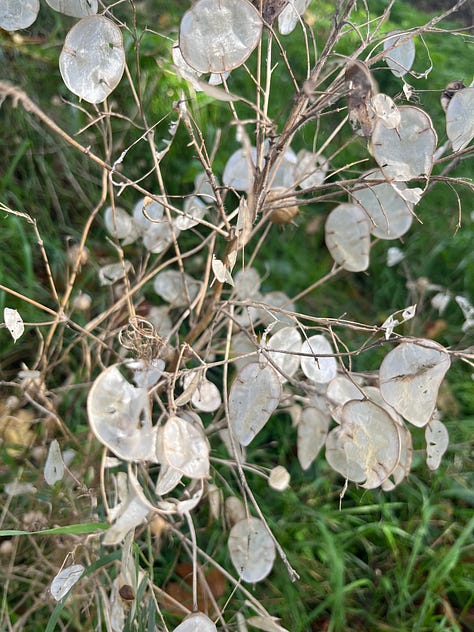


I actually felt this year as if there was a transition into autumn. Everything felt quite regular. Just enough breeze, the sense of dwindling daylight, a shift into leggings rather than shorts. Garden growth did feel stunted, but in a way that was expected because it was all discombobulated due to earlier disrupted seasons. The other signals for autumn, such as leaf fall and temperature drop helped me to bed in. My need to tidy comes from a need to root. I did this at home, in the bedroom of a shared house, where I cleaned and organised, and so too I was doing this at work. It’s breathing space, to allow it to take hold properly rather than being scattered.
For a weekend I’d been camping in Dorset during torrential rain. I went to work a trail running event from 7am until 11pm, where I watched the sky over Kimmeridge Bay change until I was sat in darkness awaiting runners coming through. I then went up North to do some running myself, along Hadrian’s Wall from Wallsend in the east to Bowness-on-Solway in the west, this time experiencing the low but warm sun and effect of dusk over Northumbrian farmland. In September and October 2023, I didn’t have this time away, so I wonder if I was impacted then in how I moved into the darker season.
I do feel for those who work in offices and so never get a true sense of the seasons, or even at the smaller level, the day. I remember days working in Selfridges department store, where I didn’t know what was going on outside, and funnily, at that time I was doing my Masters degree with investigations into how materials from our homelands embed comfort. Inside that building under artificial lighting, everything was superficial. Here, now, as a gardener and I guess as some sort of nature writer, I’m present. I’m connected. I’m aware of how I am when there’s minute changes to the way the season normally is. And I think I’m trying to preserve those familiar sensations for when we lose the seasons altogether.
Someone last night asked me if I read The Almanac, and in fact yes I have a copy but admittedly haven’t looked at it since February. I’ve just gotten it out of my “to read” box and a very mini spider came crawling out. It’s a seasonal guide, and published each year with tidbits about what to notice. During my Northern trip I found it difficult to sleep due to restless running legs, and would wake at 1am then go outside of my hostel to look at the night sky. Despite the hostel lights, Northumberland is pretty much all a Dark Sky Reserve, and the Milky Way was very very nearly visible. Mars, Jupiter and Saturn were all out, and my favourite tiny-looking constellation of the Pleiades.
I’d also connected to the season by finally after 4 months wait receiving my handmade rush hat from Paul Lewis aka Mr Thatcher, which was not quite feasible as a garden hat considering the season, but I attempted to wear it atop a balaclava anyway. I’d also been to the sample sale of a very nice brand Story mfg. where I picked up a new garden t-shirt that says “Squashes. Several types of squash are high in vitamin C” in a sort of grungey hip hop style, and wore it to go pumpkin picking in Essex. I’m ready for November.



Thank you for reading.
If you have any organic gardening queries, want to know more about something I’ve introduced, or if you live in London and want to come volunteer then do get in touch!
I’ll be back in December for November’s reflections.



